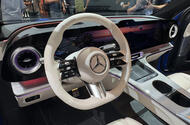German car maker admits "the data shows us physical buttons are better†despite its digital-focussed approach to interiors
Mercedes-Benz will begin to integrate more physical controls into its digitally focused cabins, as “the data shows us physical buttons are betterâ€, software boss Magnus Östberg has told Autocar.
This starts with the new GLC and CLA Shooting Brake EVs, which both get a host of rockers, rollers and buttons on a new-design steering wheel.Â
This wheel will be the standard for Mercedes’s models going forward, and the plan is also to fit it to all cars already on sale – starting later this year with the recently launched CLA saloon.
This, Östberg said, is the easiest and most cost-efficient way of adding physical controls to cars that are already on sale while still keeping Mercedes' digital-first cabins.Â
Speaking to Autocar at the Munich motor show, he explained: “You can see a difference if you move from the CLA [saloon], which has a touchscreen and fewer hard buttons, to the [new] GLC, where we put back the rollers and buttons, because we see in the data that the rollers and these physical buttons are very important for certain age groups and certain populations.
“So having that balance between physical buttons and the touch is extremely important for us. We're completely data-driven, seeing that what is actually something that is used high-frequency, the data shows us the physical buttons are better, and that's why we put them back in.â€
That data has come from software-defined vehicles: the CLA is Mercedes' first SDV and the incoming GLC the second.Â
As well as being easier to tweak (as software can be updated over the air rather than needing to drag buyers into garages), SDVs also give car makers full access to drivers’ data and usage. “This is so important,†said Östberg, as it means decisions, such as bringing back some physical controls, can be data-driven.
Due to that data, he hinted that other wheel designs could be used depending on the market. For example, while Europeans like buttons, Asian drivers prefer more touchscreen and voice controls.
Östberg said Mercedes is also looking at adding more physical controls elsewhere in the cabin for future models – but this will most likely be kept to SUVs, as “in larger cars we have more freedom to package†and buyers of those cars “care more about buttonsâ€.
The revelation comes as Mercedes has just fitted the new GLC with its biggest screen ever, and possibly the biggest to ever feature in any production car: a single-piece display named MBUX Hyperscreen that, at 39.1in, spans the entire width of the SUV’s dashboard.
Speaking at the Munich motor show, Mercedes design chief Gordon Wagener said this is probably as big as screens will get. “We have reached a point where you cannot make the screen much bigger,†he said.
How Mercedes will progress this design for its top-end models is what designers are currently looking at, as the GLC’s interior “is almost S-Class in terms of technologyâ€, said Wagener.Â
He added: “It's such a valuable piece. To get this level of luxury inside is amazing. When you look at the interior, it's amazing what we have done there. “But we can always do better; don't worry.â€
Wagener said the next stage of luxury won’t just come from high-end materials but also from software: “How can we give [the cabin] more luxury appeal? When you look at Apple and you look at [its competitors], it’s the software that feels more premium than others, and I think our software feels more premium than others.Â
“It's also all that craftsmanship that makes it a Mercedes and makes the difference to the other brands.â€
Mercedes is also looking at introducing more artificial intelligence into its cars, mainly centred around voice commands.Â
This is an important feature for buyers in China – the world’s largest car market, in which Mercedes is trying to build back a presence. But Östberg said that European buyers will also use it, and the data suggests that voice command usage in the CLA has “tripled†among Mercedes drivers. “It's phenomenal,†he said.

